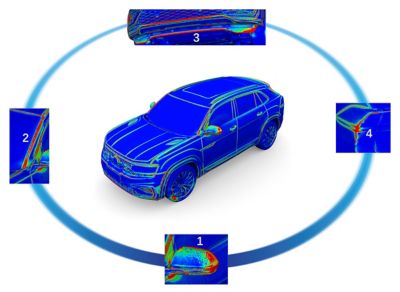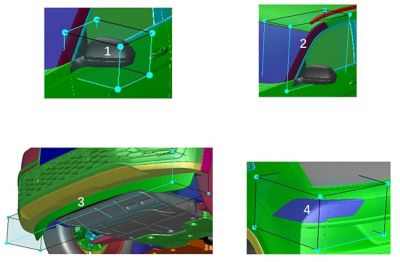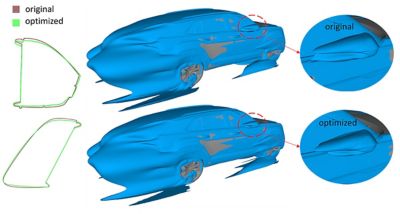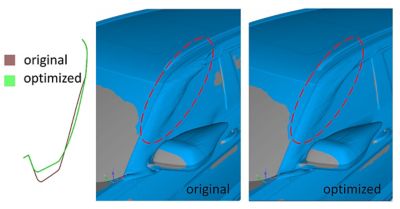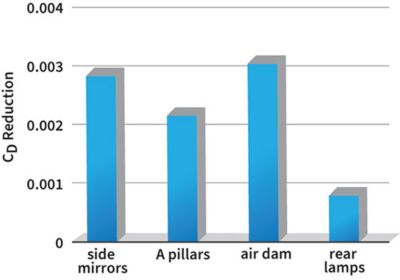-
-
학생용 무료 소프트웨어에 액세스하기
차세대 엔지니어에게 힘을 실어주는 Ansys
학생들은 세계적 수준의 시뮬레이션 소프트웨어를 무료로 이용할 수 있습니다.
-
지금 바로 Ansys에 연결하십시오!
미래를 설계하기
시뮬레이션이 다음 혁신을 어떻게 지원할 수 있는지 알아보려면 Ansys와 연결하십시오.
국가
무료 트라이얼
제품 및 서비스
학습하기
회사 정보
Back
제품 및 서비스
ANSYS ADVANTAGE MAGAZINE
January 2021
Reducing Drag for a Better World
By Ren Chao, Program Leader, Product Engineering/Predevelopment SAIC Volkswagen, Shanghai, China
Whole vehicle drag sensitivity and regions selected for optimization (1. side mirror, 2. A pillar, 3. air dam, 4 rear lamp).
Car designers work hard to improve gas mileage and battery capacity, but not all improvements come from tuned up engines and bigger batteries. Body refinements designed to reduce drag can also help. Engineers at SAIC Volkswagen in Shanghai are using Ansys Fluent Adjoint Solver to refine vehicle designs faster and more efficiently.
When it comes to automobile driving range, more is always better. Whether you are driving a car with a traditional internal combustion engine or one with a completely electric power source, the further you can go on a tank of gas or a full battery charge, the better — on your wallet as well as on the environment. Automobile companies around the world know this and design accordingly.
One path leading to better mileage with lower greenhouse gas emission targets mechanical solutions — more efficient engines and subcomponents, for example. While it may be possible to eke more efficiency out of an internal combustion engine, the fundamental technologies in play are a century old and fairly well refined. Efficiencies here are possible, but harder to achieve. Better battery designs for electric cars may be able to deliver much greater efficiencies in that space, but, again, improvements there may depend on mechanical and chemical breakthroughs that are harder to achieve.
“If we could optimize airflow around the vehicle and reduce drag through subtle refinements in design, we could improve driving range and fuel efficiency.”
A different path to better mileage performance — one gaining traction as a result of the adoption of the Worldwide Harmonized Light Vehicle Test Procedure (WLPT) — lies in reducing the drag of the vehicle. If subtle refinements in design could optimize airflow around the vehicle, driving range and fuel efficiency could improve without depending entirely on chemical and mechanical breakthroughs.
That’s exactly what SAIC Volkswagen has been doing with the help of Ansys Fluent Adjoint Solver.
Morphing boxes selected for analysis in Ansys Fluent Adjoint Solver
Adjoint Simulation Isn't New, It's Just New to Automotive
Using computer simulations to refine autobody design isn’t new, but other simulation methods have distinct limits. Approaches such as parametric simulation, design of experiments (DOE) and others are valuable, but they are highly compute-intensive and can take a long time to produce results. In a DOE approach, for example, every combination of parametric variables is simulated one by one until all possible combinations have been exhausted. If you’re working with more than a few variables, the number of calculations can become huge, and it can take days to complete all the simulations and determine which combination achieves the desired outcome. It’s also worth noting that you, as the engineer designing the simulations, need to understand how the component you’re modeling works and define the relevant parameters — which means there are optimization opportunities you may miss because you did not parameterize properly.
The adjoint method of simulation started in the world of aeronautics in the 1970s and only found its way into automotive manufacturing simulations more recently. It turns out to be a far more efficient way to solve challenges involving shapes and drag reduction. Setting up adjoint simulations does not require you to define parameters in the way you would using the DOE method, for example. You define specific goals, and the adjoint method modifies the mesh itself to achieve the stated goal within specified manufacturing constraints. In contrast to the DOE approach, the adjoint approach involves free-form shape optimization that requires very few simulations to achieve an optimized design. It also works by morphing the existing mesh, so it is not necessary to recreate mesh for different designs. As a consequence, the computational resources and time required to arrive at an optimized result are usually orders of magnitude lower than in other approaches.
The mesh morphing results and the simulated flow field. The outlines at the top of the figure show mirror shape from the side and top, respectively.
Getting More Milage From Simulation Tools
A case in point: SAIC Volkswagen recently used Ansys Fluent Adjoint Solver to explore ways to reduce drag on an existing production Volkswagen SUV. Engineers used Fluent to gain insight into areas of particular drag sensitivity, then focused on finding ways to reduce drag in several specific areas.
One of the targets included the side mirrors on the SUV. SAIC Volkswagen engineers generated surface mesh from ANSA (their preprocess software) then imported that into Fluent meshing to generate volume mesh. They then ran simulations using Ansys Fluent Adjoint Solver to optimize the body of the mirror so as to achieve the lowest drag coefficient (Cd). Using a multi-node compute cluster with 512 cores and 64 GB of memory, the Fluent simulation took between three and four hours and provided clear insights into the design alterations that could yield the lowest Cd. In contrast, had this same simulation been attempted on a similar cluster using the DOE approach, it would likely have taken two to three days to complete the simulation.
The ability to run optimization simulations in hours rather than days has important ramifications. Within the design schedule, there is only so much time to make recommendations on changes that can improve the aerodynamics of an automobile. If engineers can use Ansys Fluent Adjoint Solver to solve an optimization challenge in a matter of hours rather than days, they can perform a far greater number of simulations in the time allotted to look for solutions. That opens up a wide range of possibilities. If a designer doesn’t like the aesthetics that the changes would involve, they might incorporate other design changes with aesthetics they do like — and, in the time gained by using the adjoint simulation methods, another set of drag optimization simulations could be run on the new design to see how that performs.
Alternately, the time might be used to look for other areas where drag could be reduced for greater efficiency. In addition to analyzing the mirrors for drag optimization, SAIC Volkswagen engineers used Ansys Fluent Adjoint Solver to analyze the air dam on the SUV, the front windshield pillars and the taillight subassembly. Not only did Ansys Fluent Adjoint Solver perform all these analyses within the window of time allocated for input but the tool enabled engineers to identify opportunities for measurable drag reductions in all areas.
Comparing original vs. optimized A Pillar contours in Ansys Fluent Adjoint Solver
Not Just Hot Air
Altogether, the opportunities for optimization identified by Ansys Fluent Adjoint Solver could provide a clear boost in helping to improve the fuel efficiency of an SUV by reducing drag. SAIC Volkswagen engineers used Fluent along with the latest Generalized K-Omega (GEKO) model for steady state calculation and a high-accuracy transient Stress-Blended Eddy Simulation (SBES) model for verification, so engineering felt confident that the solutions suggested by Fluent were optimal within the conditions created by those models. Overall, the optimizations suggested by Fluent Adjoint Solver predicted a 10X reduction in Cd in the steady flow simulation and an 8X reduction in the transient flow simulation.
Still, the accuracy of these findings had to be validated, and that called for outfitting a full-sized vehicle with optimized versions of the components and then taking it for a spin in the Shanghai Automotive Wind Tunnel Center (SAWTC) in Tongji University. The trip to the wind tunnel quickly showed good compliance between the Cd reductions projected by Fluent Adjoint Solver and those measured in the wind tunnel itself.
Drag reduction after optimization
Comparing wind tunnel (test) results to Fluent simulated results
Building a Better Future
Will good compliance between Ansys Fluent Adjoint Solver and the real-world results obtained in the SAWTC eliminate the need to put cars through costly wind tunnel tests? Not entirely. The wind tunnel test provides the final word, but knowing that there is good compliance between Fluent and the real world gives engineers confidence that the Fluent Adjoint Solver’s results are going to be on target. The time gained by using an adjoint approach to simulation can be used to run more simulations, on more elements of a vehicle, in the same amount of time that previously was necessary to run only a few simulations.
Ultimately, the result is a better automobile, more efficient use of resources, lower emissions and longer range. That’s not just good for SAIC Volkswagen. It’s good for everyone.
시작하기
엔지니어링 과제에 직면하고 있다면우리 팀이 도와드리겠습니다. 풍부한 경험과 혁신에 대한 헌신을 가지고 있는 우리에게 연락해 주십시오. 협력을 통해 엔지니어링 문제를 성장과 성공의 기회로 바꾸십시오. 지금 문의하기
